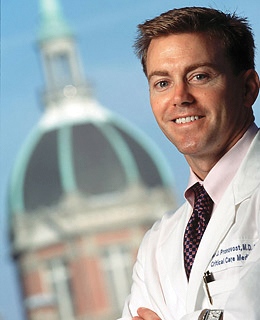- Peter Pronovost
Infobox_Scientist
name = Peter Pronovost

caption =
birth_date = 1964/5cite web | title = 2008 MacArthur Fellow: Peter Pronovost
publisher = John D. and Catherine T. MacArthur Foundation
url = http://www.macfound.org/site/c.lkLXJ8MQKrH/b.4537281/ | accessdate = 2008-09-23]
birth_place =Waterbury, Connecticut
death_date =
death_place =
residence =Baltimore, Maryland
citizenship = flagicon|USAUnited States
nationality =
ethnicity =
field =Anesthesiology
Critical Care Medicine
work_institution =Johns Hopkins Hospital
alma_mater = Fairfield, B.A.
Johns Hopkins, M.D.
Johns Hopkins, Ph.D
doctoral_advisor =
doctoral_students =
known_for = Intensive carechecklist protocol
author_abbreviation_bot =
author_abbreviation_zoo =
prizes = 2008Time 100
2008 MacArthur Fellow
footnotes =Peter Pronovost (born 1964 or 1965) is an
intensive care specialistphysician atJohns Hopkins Hospital in Baltimore,Maryland cite web
title = Peter Pronovost, MD, PhD, FCCM
publisher = Center for Innovation for Quality in Patient Care
url = http://www.hopkinsquality.com/CFI/inside/experts/CFI_IH_Pronovost.asp
accessdate = 2008-05-14] . He is a Professor in theJohns Hopkins University School of Medicine in the Departments of Anesthesiology and Critical Care Medicine, and Surgery and is Medical Director for the Center for Innovation in Quality Patient Care.He introduced an intensive care
checklist protocol that during an 18-month period saved 1500 lives and $100 million in the State ofMichigan .cite web | title = Doctor Saved Michigan $100 Million| work =All Things Considered | publisher =National Public Radio | date = December 9, 2007| url = http://www.npr.org/templates/story/story.php?storyId=17060374 | accessdate = 2008-05-14] According toAtul Gawande inThe New Yorker , Pronovost's "work has already saved more lives than that of any laboratory scientist in the past decade."cite news
last = Gawande | first = Atul | title = The 2008 TIME 100
title = The Checklist, If something so simple can transform intensive care, what else can it do?
work =New Yorker Magazine
pages = p.86
date = December 2007
url = http://www.newyorker.com/reporting/2007/12/10/071210fa_fact_gawande
accessdate = 2008-05-14]In 2008 "Time" named Pronovost one of the 100 most influential people in the worldcite news
last = Kingsbury | first = Kathleen
title = The 2008 TIME 100
work =TIME Magazine
publisher =Time Warner
date = May 2008
url = http://www.time.com/time/specials/2007/article/0,28804,1733748_1733754_1735344,00.html
accessdate = 2008-05-14] ; that same year, Pronovost was awarded a MacArthur Fellowship.Career
Pronovost grew up in
Waterbury, Connecticut . His parents were an elementary school teacher and a math professor. He received his B.S. fromFairfield University , M.D. from theJohns Hopkins School of Medicine , and Ph.D. from theJohns Hopkins Bloomberg School of Public Health .In his Ph.D. thesis at Johns Hopkins Bloomberg School of Public Health, he documented that in intensive-care units in Maryland, an intensive care specialist on the staff reduced death rates by a third.
In 2003 he founded the Quality and Safety Research Group. He has published over 200 articles and chapters on patient safety and advises the
World Health Organization on improving patient safety measurement through WHO's World Alliance for Patient Safety.cite web | title = Peter Pronovost recognised by Time Magazine | work = World Health Organization | publisher =World Health Organization | date = | url = http://www.who.int/patientsafety/news/pronovost_time_100_list/en/index.html | accessdate = 2008-05-14]He started studying hospital-acquired infections in 2001, concluding that a simple checklist protocol would greatly reduce these infections and the
medical errors that cause them.In the 2003 Michigan study called the Keystone Initiative these infections dropped at a typical ICU from 2.7 per 1,000 patients to zero. The Keystone Initiative published its results in the December, 2006 "
New England Journal of Medicine ". [cite journal |author=Pronovost P, Needham D, Berenholtz S, "et al" |title=An intervention to decrease catheter-related bloodstream infections in the ICU |journal=N. Engl. J. Med. |volume=355 |issue=26 |pages=2725–32 |year=2006 |month=December |pmid=17192537 |doi=10.1056/NEJMoa061115 |url=http://content.nejm.org/cgi/content/full/355/26/2725] In the first three months of the project, the infection rate in Michigan’s ICUs decreased by sixty-six per cent. In the Initiative’s first eighteen months, they estimated that 1500 lives and $100 million were saved. These results were sustained for almost four years.Several reasons may explain why a simple checklist protocol is not more widely adapted:
#Many physicians do not like being monitored by nurses or otherwise being forced to follow a checklist;
#A wish to avoid standardized tasks and bureaucracy; and
#A focus by researchers on "more exciting" issues such as disease biology and new treatment therapies.cite news
last = Goldsmith | first = Marshall
title = Preparing Your Professional Checklist
work =Business Week
publisher = | date = January 15, 2008
url = http://www.businessweek.com/managing/content/jan2008/ca20080115_768325.htm?chan=careers_managing+index+page_managing+your+career
accessdate = 2008-05-14]According to Provonost::The fundamental problem with the quality of American medicine is that we’ve failed to view delivery of health care as a science. The tasks of medical science fall into three buckets. One is understanding disease biology. One is finding effective therapies. And one is ensuring those therapies are delivered effectively. That third bucket has been almost totally ignored by research funders, government, and academia. It’s viewed as the art of medicine. That’s a mistake, a huge mistake. And from a taxpayer’s perspective it’s outrageous.
An internationally recognized expert on hospital safety, Pronovost has raised an alarm about the unintended consequences of computerization of patient records. [cite journal |author=Shabot MM |title=Ten commandments for implementing clinical information systems |journal=Proc (Bayl Univ Med Cent) |volume=17 |issue=3 |pages=265–9 |year=2004 |month=July |pmid=16200110 PMC|1200662]
ee also
*
Evidence-based medicine
*Iatrogenesis
*Medical error
*Patient safety References
External links
* [https://jshare.johnshopkins.edu/gkim9/public_html/PronovostTestimonyApr162008.doc?uniq=-cbj3dn Peter J. Pronovost, Testimony before Government Oversight Committee, April 16, 2008] from johnshopkins.edu
* [http://www.macfound.org/site/apps/nlnet/content3.aspx?c=lkLXJ8MQKrH&b=4513915&ct=5984655 Video] from the MacArthur Fellow website
* [http://safetyresearch.jhu.edu/qsr/ Johns Hopkins University Quality and Safety Research Group] from jhu.edu
Wikimedia Foundation. 2010.
